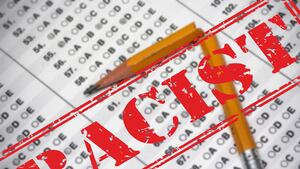COVID-19, which has caused so much damage to America, might also be what finally kills the SAT and ACT, the high-stakes college admissions tests administered by the Educational Testing Service and that largely determine access to higher education. In a typical year, 77 percent of high school graduates took these tests. This year it was only 44 percent. That is a seismic shift, and one worth cheering should it prove permanent.
Generations of high school students have stressed over the 70-year-old SAT test while parents with the means pay test prep and tutors enough to support a $30 billion test-prep industry that’s helped to widen the American opportunity gap, with the haves accumulating advantages while the have-nots don’t even know the rules of the game they are playing.
For nearly as long as the test has been around, educational researchers have decried the unfairness of this system, and the pressures and anxieties it has placed on young men and women. They have pointed out how students from marginalized communities see limited access to higher education.
And while these tests were never intended to be the gatekeepers they have become, but rather one of several tools for assessing applicants, for many large, regional public institutions—the type that serves the majority of students from lower-income families—they have become the first and often primary sorting mechanism for entry.
Prior to COVID-19, some Ivies and small-to-mid-sized private schools had started moving away from high-stakes testing, declaring themselves test-optional. They had the resources and time to review each applicant holistically. As industry news site Edsurge reported: “Even before the pandemic, test-optional policies were gaining traction [as] academic indicators such as GPA and class rank were sufficient on their own.” SAT scores, those schools realized, were more reflective of applicants’ family income levels than they were of students’ likelihood of succeeding in college.
It is as if there was a race set up so that some begin further down the track when the whistle blows. Students who have taken prep classes or worked with tutors are considerably more comfortable with the process and know what to expect. Some also take the test more than once. In fact, research on the percentage of high school graduates who have taken these tests over the past 30 years shows an interesting trend: in the period of 2010-2017 more than 100 percent of those graduating took the test. Curious. According to a recent Bureau of Labor Statistics report, “Among recent high school graduates ages 16 to 24, college enrollment rates for men and women were 62.0 percent and 69.8 percent, respectively.” That’s a lot of students taking the test two or even more times to lock in a higher score.
The pandemic changed that, and over 1,350 schools now have test-optional policies according to Fairtest, a group that researches fairness and equity in testing, upending the college admissions system that was built on the centrality of ETS and its two big tests.
The SAT came out of the experience of psychologist and eugenicist Robert Yarkes, who convinced the Army during WWI to administer mass IQ tests to U.S. soldiers. After the war, a member of his team, Carl Brigham, then teaching at Princeton University, adapted the Army Alpha test for use as a college admissions examination, beginning in 1926.
Then a new Harvard president, James Bryant Conant, started using the exam to identify “gifted” students and “hidden” talent outside of the orbit of the eastern private boarding schools that to that point had been the sole Harvard pipeline. Henry Chauncey, a Harvard Dean, was tasked by Conant to identify an exam and in 1942 he and Brigham convinced the College Board members to shift to the test that became the SATs for all college admissions testing purposes. And soon ETS, headquartered in Princeton, NJ, was born.
But there’s a darker history to this testing system, as Bruce Hammond detailed in an InsideHigherEd essay published in 2020: “In 1923, Carl Brigham published A Study of American Intelligence, in which he wrote that testing showed the superiority of ‘the Nordic race group’ and warned of the ‘promiscuous intermingling’ of these new immigrants in the American gene pool. Shortly after the book’s publication, the College Board commissioned him to lead the development of the SAT…”
Despite its origins, there have always been defenders of this test who believe as Harvard’s Conant did that it can help identify hidden pools of talented students. Andrew Sullivan, a current example of this thinking, recently wrote that “kids who would be otherwise lost in poverty or broken families or terrible schools are uniquely discovered by this test” and given opportunities.
But while that has been widely recognized in recent years as a reductionist and tokenistic perspective, it took the devastation of the virus to knock ETS off of its longtime perch as higher education institutions and K-12 classrooms alike focused less on testing. When colleges went remote last March as many states went into lockdown, there was a great deal of confusion and uncertainty. And while the public focus was understandably on the impact of remote education on current students, this all happened during admissions season.
At first, ETS announced it would roll-out online versions of the tests that could be taken safely at home. But, as you can imagine, this was complicated and admissions officials had many questions such as how could ETS ensure against cheating and what to do with students who did not have computers or broadband WiFi. ETS asked colleges for patience to allow students to take delayed tests, but they kept postponing or canceling test dates for various health and safety reasons. Colleges found themselves in a bind as they needed to get their incoming classes settled asap (enrollments are tied to budgets, and budgets have been even tighter than usual in COVID times).
When the University of California system, one of the nation’s largest and most prestigious public systems, announced last May that it was going test-optional until 2025 it opened the floodgates, as other big schools and state systems quickly followed including CUNY, SUNY, Cal State, and UMass, and the list quickly grew longer and longer.
These schools did what many said could never be done in shifting to a whole-student admissions approach, with many deciding to keep the tests optional for several years to see how those classes compare to previous ones. It is a large-scale field test of a new admissions system that would not have happened were it not for the COVID crisis.
Even the looming enrollment crisis (caused by the demographic decline of the college-age population) couldn’t dislodge testing. While secretly many admissions professionals recognized the limits of testing as the predictor, fear of risking so much on shifting away kept everyone in line. But COVID has allowed or even forced, administrators to question the value of testing, and thus we stand at the doorway of a new college admissions system, one being built on the fly during a 100-year pandemic. And while some form of reformed or limited testing might survive, it is clear that we will not simply return to the pre-COVID ways when the pandemic is done.
When Harvard’s Conant moved to a new admissions system, less than 10 percent of Americans had a college degree. Since then, a college education has become increasingly critical to economic success and, of course, increasingly expensive. College admissions are central to class mobility in America, which is why the Big Test has caused so much stress.
It won’t be easy to find a 21st-century college admission process, but that work has finally begun 20 years into the century. Let’s strive for a system that finally works for the majority of those who hope to be college bound.






